Weixin Li
Amy
PolySim: Bridging the Sim-to-Real Gap for Humanoid Control via Multi-Simulator Dynamics Randomization
Oct 02, 2025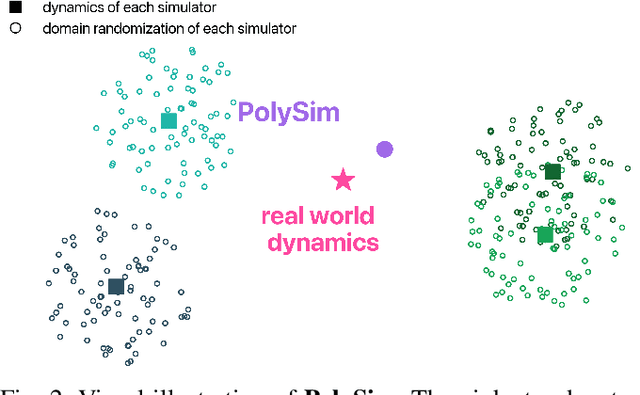
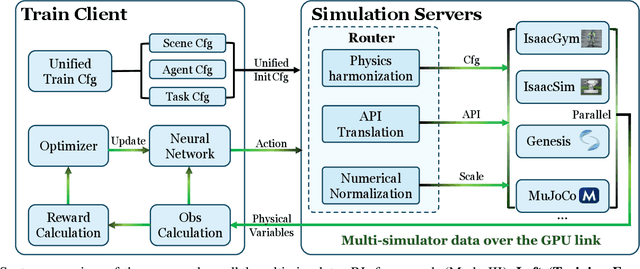
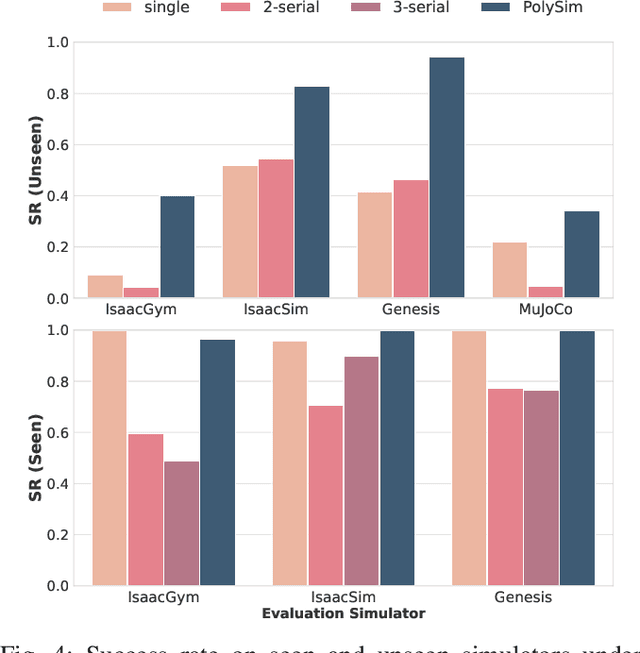
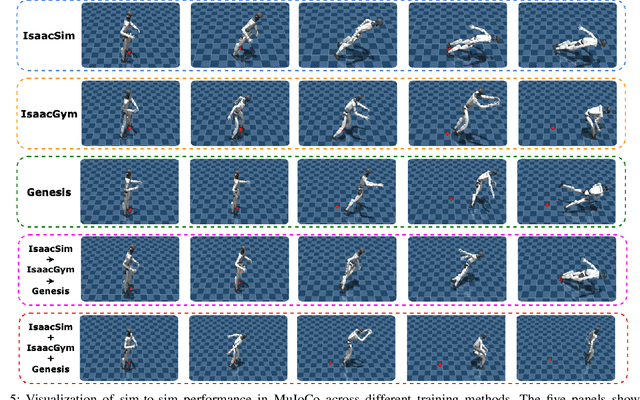
Abstract:Humanoid whole-body control (WBC) policies trained in simulation often suffer from the sim-to-real gap, which fundamentally arises from simulator inductive bias, the inherent assumptions and limitations of any single simulator. These biases lead to nontrivial discrepancies both across simulators and between simulation and the real world. To mitigate the effect of simulator inductive bias, the key idea is to train policies jointly across multiple simulators, encouraging the learned controller to capture dynamics that generalize beyond any single simulator's assumptions. We thus introduce PolySim, a WBC training platform that integrates multiple heterogeneous simulators. PolySim can launch parallel environments from different engines simultaneously within a single training run, thereby realizing dynamics-level domain randomization. Theoretically, we show that PolySim yields a tighter upper bound on simulator inductive bias than single-simulator training. In experiments, PolySim substantially reduces motion-tracking error in sim-to-sim evaluations; for example, on MuJoCo, it improves execution success by 52.8 over an IsaacSim baseline. PolySim further enables zero-shot deployment on a real Unitree G1 without additional fine-tuning, showing effective transfer from simulation to the real world. We will release the PolySim code upon acceptance of this work.
Multi-Grained Compositional Visual Clue Learning for Image Intent Recognition
Apr 25, 2025Abstract:In an era where social media platforms abound, individuals frequently share images that offer insights into their intents and interests, impacting individual life quality and societal stability. Traditional computer vision tasks, such as object detection and semantic segmentation, focus on concrete visual representations, while intent recognition relies more on implicit visual clues. This poses challenges due to the wide variation and subjectivity of such clues, compounded by the problem of intra-class variety in conveying abstract concepts, e.g. "enjoy life". Existing methods seek to solve the problem by manually designing representative features or building prototypes for each class from global features. However, these methods still struggle to deal with the large visual diversity of each intent category. In this paper, we introduce a novel approach named Multi-grained Compositional visual Clue Learning (MCCL) to address these challenges for image intent recognition. Our method leverages the systematic compositionality of human cognition by breaking down intent recognition into visual clue composition and integrating multi-grained features. We adopt class-specific prototypes to alleviate data imbalance. We treat intent recognition as a multi-label classification problem, using a graph convolutional network to infuse prior knowledge through label embedding correlations. Demonstrated by a state-of-the-art performance on the Intentonomy and MDID datasets, our approach advances the accuracy of existing methods while also possessing good interpretability. Our work provides an attempt for future explorations in understanding complex and miscellaneous forms of human expression.
Generating Editable Head Avatars with 3D Gaussian GANs
Dec 26, 2024



Abstract:Generating animatable and editable 3D head avatars is essential for various applications in computer vision and graphics. Traditional 3D-aware generative adversarial networks (GANs), often using implicit fields like Neural Radiance Fields (NeRF), achieve photorealistic and view-consistent 3D head synthesis. However, these methods face limitations in deformation flexibility and editability, hindering the creation of lifelike and easily modifiable 3D heads. We propose a novel approach that enhances the editability and animation control of 3D head avatars by incorporating 3D Gaussian Splatting (3DGS) as an explicit 3D representation. This method enables easier illumination control and improved editability. Central to our approach is the Editable Gaussian Head (EG-Head) model, which combines a 3D Morphable Model (3DMM) with texture maps, allowing precise expression control and flexible texture editing for accurate animation while preserving identity. To capture complex non-facial geometries like hair, we use an auxiliary set of 3DGS and tri-plane features. Extensive experiments demonstrate that our approach delivers high-quality 3D-aware synthesis with state-of-the-art controllability. Our code and models are available at https://github.com/liguohao96/EGG3D.
Consistent Diffusion: Denoising Diffusion Model with Data-Consistent Training for Image Restoration
Dec 17, 2024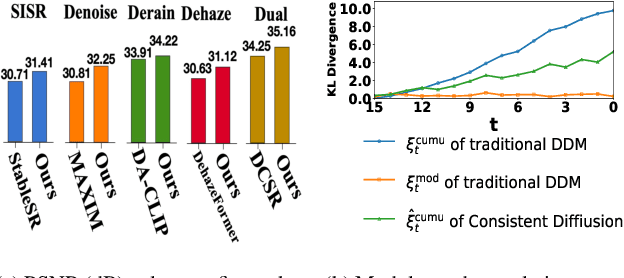
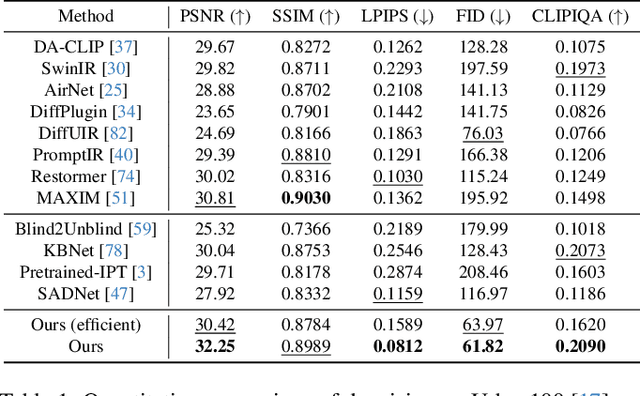


Abstract:In this work, we address the limitations of denoising diffusion models (DDMs) in image restoration tasks, particularly the shape and color distortions that can compromise image quality. While DDMs have demonstrated a promising performance in many applications such as text-to-image synthesis, their effectiveness in image restoration is often hindered by shape and color distortions. We observe that these issues arise from inconsistencies between the training and testing data used by DDMs. Based on our observation, we propose a novel training method, named data-consistent training, which allows the DDMs to access images with accumulated errors during training, thereby ensuring the model to learn to correct these errors. Experimental results show that, across five image restoration tasks, our method has significant improvements over state-of-the-art methods while effectively minimizing distortions and preserving image fidelity.
Leveraging Predicate and Triplet Learning for Scene Graph Generation
Jun 04, 2024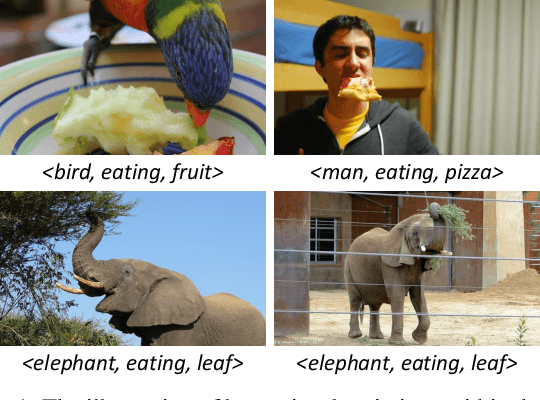

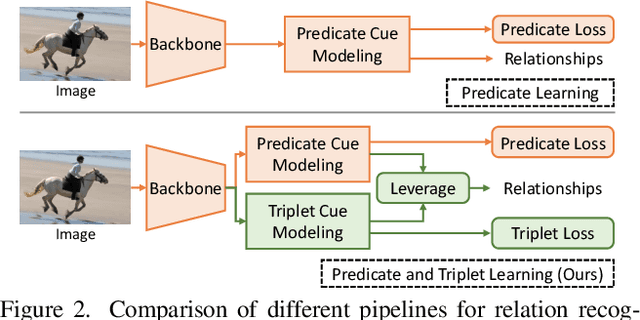

Abstract:Scene Graph Generation (SGG) aims to identify entities and predict the relationship triplets \textit{\textless subject, predicate, object\textgreater } in visual scenes. Given the prevalence of large visual variations of subject-object pairs even in the same predicate, it can be quite challenging to model and refine predicate representations directly across such pairs, which is however a common strategy adopted by most existing SGG methods. We observe that visual variations within the identical triplet are relatively small and certain relation cues are shared in the same type of triplet, which can potentially facilitate the relation learning in SGG. Moreover, for the long-tail problem widely studied in SGG task, it is also crucial to deal with the limited types and quantity of triplets in tail predicates. Accordingly, in this paper, we propose a Dual-granularity Relation Modeling (DRM) network to leverage fine-grained triplet cues besides the coarse-grained predicate ones. DRM utilizes contexts and semantics of predicate and triplet with Dual-granularity Constraints, generating compact and balanced representations from two perspectives to facilitate relation recognition. Furthermore, a Dual-granularity Knowledge Transfer (DKT) strategy is introduced to transfer variation from head predicates/triplets to tail ones, aiming to enrich the pattern diversity of tail classes to alleviate the long-tail problem. Extensive experiments demonstrate the effectiveness of our method, which establishes new state-of-the-art performance on Visual Genome, Open Image, and GQA datasets. Our code is available at \url{https://github.com/jkli1998/DRM}
ReWiTe: Realistic Wide-angle and Telephoto Dual Camera Fusion Dataset via Beam Splitter Camera Rig
Apr 16, 2024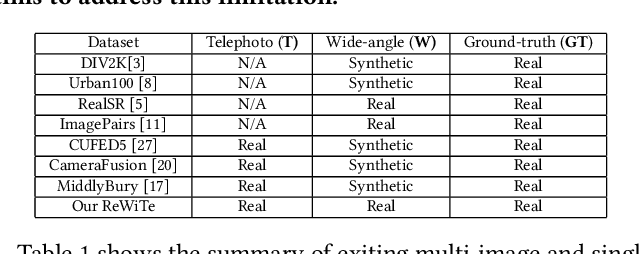
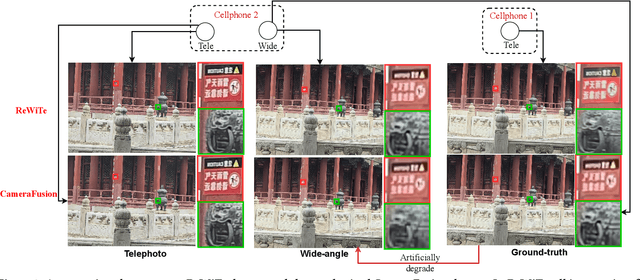

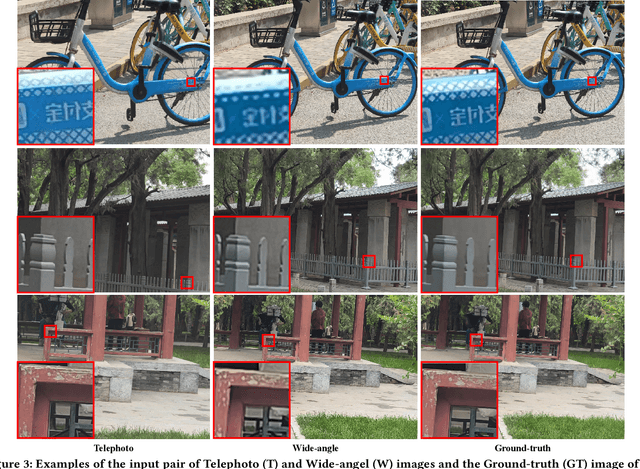
Abstract:The fusion of images from dual camera systems featuring a wide-angle and a telephoto camera has become a hotspot problem recently. By integrating simultaneously captured wide-angle and telephoto images from these systems, the resulting fused image achieves a wide field of view (FOV) coupled with high-definition quality. Existing approaches are mostly deep learning methods, and predominantly rely on supervised learning, where the training dataset plays a pivotal role. However, current datasets typically adopt a data synthesis approach generate input pairs of wide-angle and telephoto images alongside ground-truth images. Notably, the wide-angle inputs are synthesized rather than captured using real wide-angle cameras, and the ground-truth image is captured by wide-angle camera whose quality is substantially lower than that of input telephoto images captured by telephoto cameras. To address these limitations, we introduce a novel hardware setup utilizing a beam splitter to simultaneously capture three images, i.e. input pairs and ground-truth images, from two authentic cellphones equipped with wide-angle and telephoto dual cameras. Specifically, the wide-angle and telephoto images captured by cellphone 2 serve as the input pair, while the telephoto image captured by cellphone 1, which is calibrated to match the optical path of the wide-angle image from cellphone 2, serves as the ground-truth image, maintaining quality on par with the input telephoto image. Experiments validate the efficacy of our newly introduced dataset, named ReWiTe, significantly enhances the performance of various existing methods for real-world wide-angle and telephoto dual image fusion tasks.
BMLP: Behavior-aware MLP for Heterogeneous Sequential Recommendation
Feb 20, 2024Abstract:In real recommendation scenarios, users often have different types of behaviors, such as clicking and buying. Existing research methods show that it is possible to capture the heterogeneous interests of users through different types of behaviors. However, most multi-behavior approaches have limitations in learning the relationship between different behaviors. In this paper, we propose a novel multilayer perceptron (MLP)-based heterogeneous sequential recommendation method, namely behavior-aware multilayer perceptron (BMLP). Specifically, it has two main modules, including a heterogeneous interest perception (HIP) module, which models behaviors at multiple granularities through behavior types and transition relationships, and a purchase intent perception (PIP) module, which adaptively fuses subsequences of auxiliary behaviors to capture users' purchase intent. Compared with mainstream sequence models, MLP is competitive in terms of accuracy and has unique advantages in simplicity and efficiency. Extensive experiments show that BMLP achieves significant improvement over state-of-the-art algorithms on four public datasets. In addition, its pure MLP architecture leads to a linear time complexity.
View Transition based Dual Camera Image Fusion
Dec 18, 2023Abstract:The dual camera system of wide-angle ($\bf{W}$) and telephoto ($\bf{T}$) cameras has been widely adopted by popular phones. In the overlap region, fusing the $\bf{W}$ and $\bf{T}$ images can generate a higher quality image. Related works perform pixel-level motion alignment or high-dimensional feature alignment of the $\bf{T}$ image to the view of the $\bf{W}$ image and then perform image/feature fusion, but the enhancement in occlusion area is ill-posed and can hardly utilize data from $\bf{T}$ images. Our insight is to minimize the occlusion area and thus maximize the use of pixels from $\bf{T}$ images. Instead of insisting on placing the output in the $\bf{W}$ view, we propose a view transition method to transform both $\bf{W}$ and $\bf{T}$ images into a mixed view and then blend them into the output. The transformation ratio is kept small and not apparent to users, and the center area of the output, which has accumulated a sufficient amount of transformation, can directly use the contents from the T view to minimize occlusions. Experimental results show that, in comparison with the SOTA methods, occlusion area is largely reduced by our method and thus more pixels of the $\bf{T}$ image can be used for improving the quality of the output image.
Zero-Shot Scene Graph Generation via Triplet Calibration and Reduction
Sep 07, 2023



Abstract:Scene Graph Generation (SGG) plays a pivotal role in downstream vision-language tasks. Existing SGG methods typically suffer from poor compositional generalizations on unseen triplets. They are generally trained on incompletely annotated scene graphs that contain dominant triplets and tend to bias toward these seen triplets during inference. To address this issue, we propose a Triplet Calibration and Reduction (T-CAR) framework in this paper. In our framework, a triplet calibration loss is first presented to regularize the representations of diverse triplets and to simultaneously excavate the unseen triplets in incompletely annotated training scene graphs. Moreover, the unseen space of scene graphs is usually several times larger than the seen space since it contains a huge number of unrealistic compositions. Thus, we propose an unseen space reduction loss to shift the attention of excavation to reasonable unseen compositions to facilitate the model training. Finally, we propose a contextual encoder to improve the compositional generalizations of unseen triplets by explicitly modeling the relative spatial relations between subjects and objects. Extensive experiments show that our approach achieves consistent improvements for zero-shot SGG over state-of-the-art methods. The code is available at https://github.com/jkli1998/T-CAR.
Ground-truth dataset and baseline evaluations for image base-detail separation algorithms
Feb 18, 2016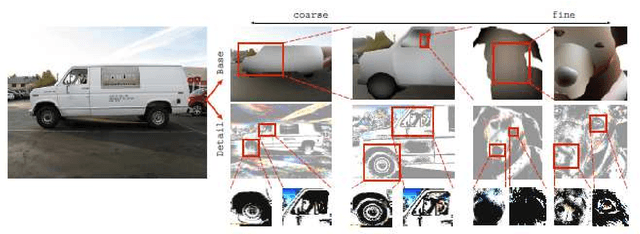


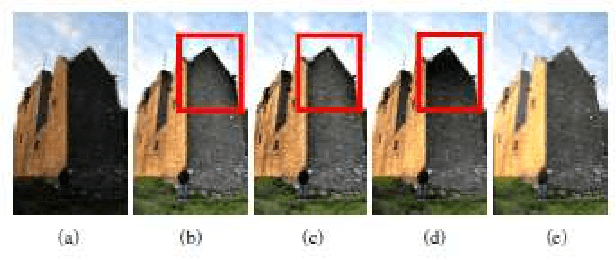
Abstract:Base-detail separation is a fundamental computer vision problem consisting of modeling a smooth base layer with the coarse structures, and a detail layer containing the texture-like structures. One of the challenges of estimating the base is to preserve sharp boundaries between objects or parts to avoid halo artifacts. Many methods have been proposed to address this problem, but there is no ground-truth dataset of real images for quantitative evaluation. We proposed a procedure to construct such a dataset, and provide two datasets: Pascal Base-Detail and Fashionista Base-Detail, containing 1000 and 250 images, respectively. Our assumption is that the base is piecewise smooth and we label the appearance of each piece by a polynomial model. The pieces are objects and parts of objects, obtained from human annotations. Finally, we proposed a way to evaluate methods with our base-detail ground-truth and we compared the performances of seven state-of-the-art algorithms.
 Add to Chrome
Add to Chrome Add to Firefox
Add to Firefox Add to Edge
Add to Edge